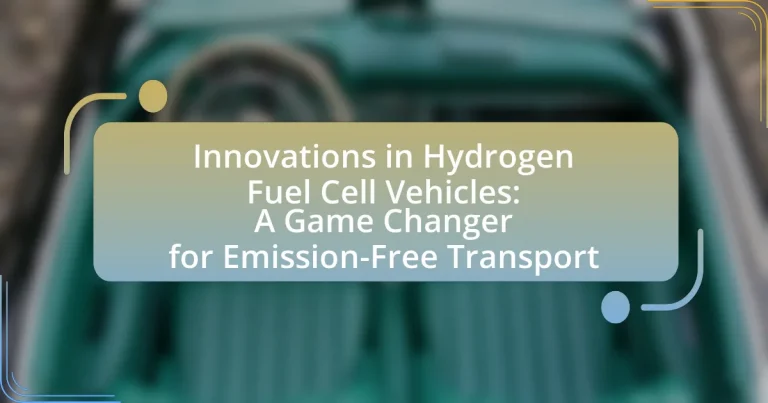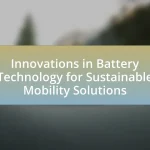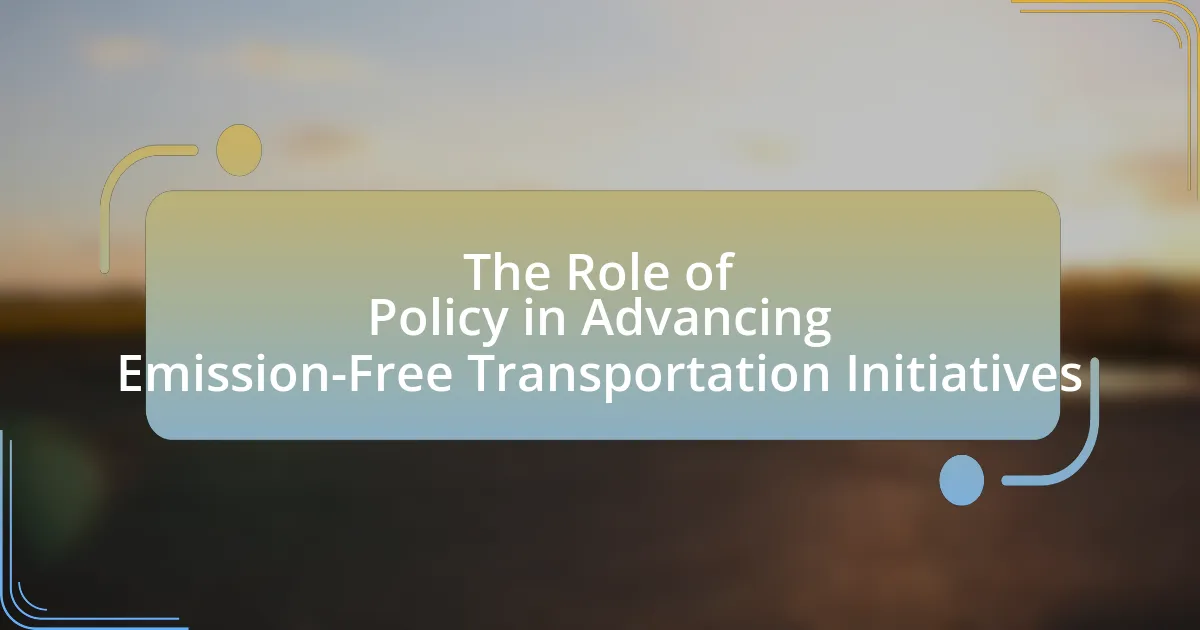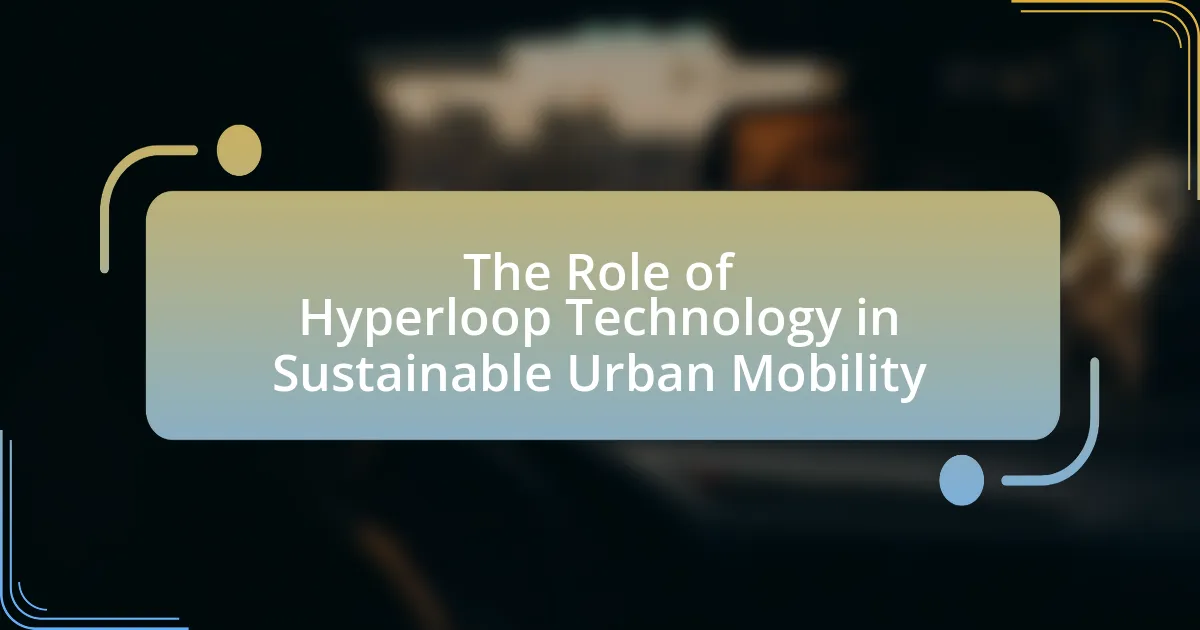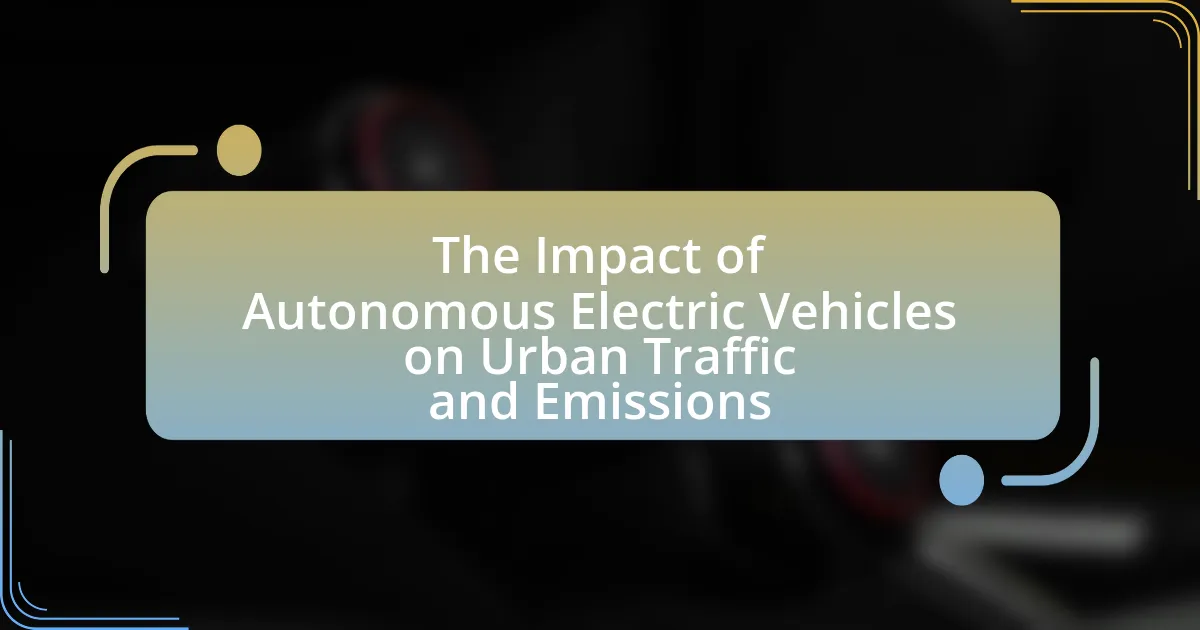Hydrogen Fuel Cell Vehicles (HFCVs) represent a significant advancement in emission-free transportation, utilizing hydrogen gas to power electric motors through a chemical reaction in fuel cells. This article explores the operational mechanics of HFCVs, highlighting their efficiency, zero-emission output, and the key components of their fuel cell systems. It also examines the production methods for hydrogen, the advantages HFCVs hold over traditional vehicles, and the economic benefits associated with their adoption. Furthermore, the article discusses recent innovations in hydrogen fuel cell technology, challenges facing the market, and strategies to enhance public awareness and infrastructure development, ultimately positioning HFCVs as a viable solution for sustainable transport.

What are Hydrogen Fuel Cell Vehicles?
Hydrogen Fuel Cell Vehicles (HFCVs) are automobiles that use hydrogen gas to power an electric motor through a chemical reaction in a fuel cell. This process combines hydrogen with oxygen from the air, producing electricity, water, and heat, with water being the only emission. HFCVs are recognized for their efficiency and potential to reduce greenhouse gas emissions, as they can achieve a range comparable to traditional gasoline vehicles while refueling in a matter of minutes. According to the U.S. Department of Energy, HFCVs can convert about 60% of the energy in hydrogen to power at the wheels, significantly higher than internal combustion engines, which typically convert only about 20% of the energy stored in gasoline.
How do Hydrogen Fuel Cell Vehicles operate?
Hydrogen Fuel Cell Vehicles (FCVs) operate by converting hydrogen gas into electricity through a chemical reaction in a fuel cell. In this process, hydrogen from the vehicle’s tank reacts with oxygen from the air, producing electricity, water, and heat. The electricity generated powers the electric motor, which drives the vehicle.
This operation is efficient, with fuel cells achieving up to 60% efficiency compared to traditional internal combustion engines, which typically operate at around 20% efficiency. Additionally, the only byproduct of this reaction is water vapor, making FCVs a zero-emission transportation option.
What are the key components of a hydrogen fuel cell system?
The key components of a hydrogen fuel cell system are the fuel cell stack, hydrogen storage, air supply system, and power conditioning system. The fuel cell stack is where the electrochemical reaction occurs, converting hydrogen and oxygen into electricity, water, and heat. Hydrogen storage is essential for safely storing the hydrogen fuel, typically using high-pressure tanks. The air supply system provides the necessary oxygen for the reaction, while the power conditioning system manages the electricity output to ensure it meets the requirements of the electric motor or other applications. These components work together to enable efficient energy conversion and support emission-free transport.
How is hydrogen produced for fuel cell vehicles?
Hydrogen for fuel cell vehicles is primarily produced through methods such as steam methane reforming (SMR), electrolysis, and gasification. Steam methane reforming, which accounts for about 95% of hydrogen production, involves reacting natural gas with steam to produce hydrogen and carbon dioxide. Electrolysis, a cleaner method, uses electricity to split water into hydrogen and oxygen, and is increasingly powered by renewable energy sources. Gasification converts organic materials into hydrogen and other products through high-temperature reactions with limited oxygen. These methods are essential for supplying hydrogen fuel to support the growing market for fuel cell vehicles, which aim to reduce greenhouse gas emissions and reliance on fossil fuels.
What advantages do Hydrogen Fuel Cell Vehicles offer over traditional vehicles?
Hydrogen Fuel Cell Vehicles (HFCVs) offer several advantages over traditional vehicles, primarily in terms of environmental impact and efficiency. HFCVs produce only water vapor as a byproduct, significantly reducing greenhouse gas emissions compared to gasoline or diesel vehicles, which emit carbon dioxide and other pollutants. Additionally, HFCVs have a higher energy efficiency, converting about 60% of the hydrogen’s energy into usable power, while traditional internal combustion engines typically convert only about 20% of the fuel’s energy. Furthermore, HFCVs can be refueled in approximately five minutes, similar to conventional vehicles, while offering a longer driving range, often exceeding 300 miles on a single tank of hydrogen. These factors collectively position hydrogen fuel cell technology as a promising alternative for sustainable transportation.
How do Hydrogen Fuel Cell Vehicles contribute to reducing emissions?
Hydrogen Fuel Cell Vehicles (FCVs) contribute to reducing emissions by producing only water vapor as a byproduct during operation, thus eliminating harmful tailpipe emissions. Unlike conventional vehicles that emit carbon dioxide and other pollutants, FCVs convert hydrogen gas into electricity through a chemical reaction, which powers the vehicle. According to the U.S. Department of Energy, hydrogen fuel cells can achieve efficiencies of up to 60%, significantly reducing greenhouse gas emissions compared to internal combustion engines. Additionally, when hydrogen is produced from renewable sources, the overall lifecycle emissions are further minimized, reinforcing the role of FCVs in promoting cleaner transportation solutions.
What are the economic benefits of adopting Hydrogen Fuel Cell Vehicles?
Adopting Hydrogen Fuel Cell Vehicles (HFCVs) offers significant economic benefits, including reduced fuel costs and lower maintenance expenses. HFCVs typically have higher energy efficiency compared to traditional internal combustion engine vehicles, leading to lower operational costs. For instance, hydrogen fuel can be produced from various renewable sources, potentially decreasing dependency on fossil fuels and stabilizing fuel prices. Additionally, HFCVs have fewer moving parts than conventional vehicles, resulting in reduced maintenance costs; studies indicate that maintenance expenses can be up to 30% lower for HFCVs. Furthermore, the growth of the hydrogen economy can create jobs in manufacturing, infrastructure development, and fuel production, contributing positively to local economies.

What recent innovations have emerged in Hydrogen Fuel Cell Technology?
Recent innovations in hydrogen fuel cell technology include advancements in membrane materials, such as the development of proton exchange membranes that enhance efficiency and durability. These new membranes, like those made from advanced polymers, significantly improve the performance of fuel cells by allowing for higher proton conductivity while reducing costs. Additionally, breakthroughs in hydrogen production methods, such as electrolysis using renewable energy sources, have made hydrogen more sustainable and economically viable. Research from the National Renewable Energy Laboratory indicates that these innovations can lead to a 30% reduction in costs for hydrogen production by 2030, further supporting the transition to emission-free transport.
How have advancements in materials improved fuel cell efficiency?
Advancements in materials have significantly improved fuel cell efficiency by enhancing conductivity and reducing catalyst costs. For instance, the development of proton exchange membranes (PEMs) with higher proton conductivity allows for better ion transport, which increases overall cell performance. Additionally, the use of advanced catalysts, such as platinum alloys and non-precious metal catalysts, has decreased the amount of expensive platinum needed, making fuel cells more economically viable while maintaining high efficiency. Research indicates that these material innovations can lead to fuel cell systems achieving efficiencies above 60%, compared to traditional systems that often fall below this threshold.
What role do catalysts play in enhancing fuel cell performance?
Catalysts significantly enhance fuel cell performance by accelerating the electrochemical reactions that convert hydrogen and oxygen into electricity. In fuel cells, catalysts, typically made from precious metals like platinum, lower the activation energy required for these reactions, thereby increasing the reaction rate and overall efficiency. For instance, the use of platinum-based catalysts can improve the power output of hydrogen fuel cells by facilitating faster electron transfer and reducing energy losses during operation. This efficiency is crucial for the viability of hydrogen fuel cell vehicles, as it directly impacts their range and performance, making them a competitive option for emission-free transport.
How has the development of lightweight materials impacted vehicle design?
The development of lightweight materials has significantly enhanced vehicle design by improving fuel efficiency and performance. Lightweight materials, such as carbon fiber and aluminum, reduce the overall weight of vehicles, which directly correlates to lower energy consumption and increased range, particularly in hydrogen fuel cell vehicles. For instance, a reduction of 10% in vehicle weight can lead to a 6-8% improvement in fuel efficiency, as demonstrated in studies by the U.S. Department of Energy. This shift not only allows for better acceleration and handling but also enables manufacturers to optimize space for hydrogen fuel systems, ultimately contributing to the advancement of emission-free transport solutions.
What technological breakthroughs are shaping the future of Hydrogen Fuel Cell Vehicles?
Technological breakthroughs shaping the future of Hydrogen Fuel Cell Vehicles include advancements in hydrogen production, fuel cell efficiency, and storage solutions. Innovations such as electrolysis using renewable energy sources have significantly improved the sustainability of hydrogen production, making it more environmentally friendly. Additionally, the development of high-performance fuel cells, like those utilizing proton exchange membranes, has enhanced energy conversion efficiency, allowing vehicles to achieve greater ranges and faster refueling times. Furthermore, advancements in hydrogen storage technologies, including lightweight composite tanks, have increased the safety and practicality of hydrogen storage, facilitating broader adoption of fuel cell vehicles. These breakthroughs collectively contribute to the viability and attractiveness of hydrogen fuel cell technology in the automotive sector.
How are advancements in hydrogen storage solutions influencing vehicle range?
Advancements in hydrogen storage solutions are significantly increasing vehicle range by enabling higher storage densities and more efficient fuel utilization. For instance, the development of composite pressure vessels and metal hydrides allows for greater hydrogen storage capacity within the same physical space, which directly translates to longer driving distances. Research indicates that these innovations can enhance the energy density of hydrogen storage systems, with some technologies achieving up to 6 kg of hydrogen per 100 liters, compared to traditional methods. This increase in storage efficiency not only extends the range of hydrogen fuel cell vehicles but also improves their overall performance and practicality for consumers.
What innovations in refueling infrastructure are being implemented?
Innovations in refueling infrastructure for hydrogen fuel cell vehicles include the development of high-capacity hydrogen refueling stations and advancements in electrolyzer technology. High-capacity stations are designed to reduce refueling time and increase the availability of hydrogen, addressing the current limitations in infrastructure. For instance, some stations are now capable of dispensing hydrogen at pressures of up to 700 bar, significantly improving efficiency. Additionally, advancements in electrolyzer technology, such as proton exchange membrane (PEM) electrolyzers, enhance the production of green hydrogen from renewable energy sources, making the refueling process more sustainable. These innovations are crucial for supporting the growing adoption of hydrogen fuel cell vehicles and facilitating a transition to emission-free transport.

What challenges do Hydrogen Fuel Cell Vehicles face in the market?
Hydrogen Fuel Cell Vehicles (HFCVs) face several significant challenges in the market, primarily including high production costs, limited refueling infrastructure, and consumer awareness issues. The production of hydrogen fuel cells is currently expensive due to the reliance on precious metals like platinum, which increases the overall cost of HFCVs. Additionally, the lack of widespread hydrogen refueling stations limits the practicality of HFCVs for consumers, as they often cannot find convenient locations to refuel. Furthermore, consumer awareness and understanding of hydrogen technology remain low, which hinders market adoption. According to a 2021 report by the International Energy Agency, only about 500 hydrogen refueling stations were operational worldwide, highlighting the infrastructure challenge.
What are the current barriers to widespread adoption of Hydrogen Fuel Cell Vehicles?
The current barriers to widespread adoption of Hydrogen Fuel Cell Vehicles (HFCVs) include high production costs, limited refueling infrastructure, and consumer awareness challenges. High production costs stem from the expensive materials required for fuel cells, such as platinum, which can hinder affordability and scalability. Limited refueling infrastructure is a significant issue, as there are only about 50 hydrogen refueling stations in the United States, making it difficult for consumers to find convenient refueling options. Additionally, consumer awareness challenges arise from a lack of understanding of HFCVs and their benefits compared to battery electric vehicles, which are more widely recognized and available. These factors collectively impede the growth of the HFCV market.
How does the cost of hydrogen production affect vehicle pricing?
The cost of hydrogen production directly influences vehicle pricing by determining the overall expenses associated with hydrogen fuel cell technology. When hydrogen production costs are high, manufacturers face increased operational costs, which are often passed on to consumers in the form of higher vehicle prices. For instance, if the production cost of hydrogen is around $5 per kilogram, it can significantly impact the pricing of hydrogen fuel cell vehicles, making them less competitive compared to traditional gasoline or electric vehicles. Conversely, advancements in production methods that lower hydrogen costs, such as electrolysis using renewable energy, can lead to reduced vehicle prices, enhancing market adoption.
What regulatory challenges impact the hydrogen fuel cell industry?
The hydrogen fuel cell industry faces several regulatory challenges, including the lack of standardized safety protocols, inconsistent government policies, and insufficient infrastructure support. Safety regulations vary significantly across regions, leading to uncertainty for manufacturers and investors. Additionally, government incentives and subsidies for hydrogen technologies are not uniformly applied, which can hinder market growth. Furthermore, the development of refueling infrastructure is often slow due to regulatory hurdles, limiting the adoption of hydrogen fuel cell vehicles. These challenges collectively impede the industry’s ability to scale and compete effectively in the broader clean energy market.
How can these challenges be addressed to promote growth?
To address the challenges in hydrogen fuel cell vehicle (HFCV) adoption and promote growth, stakeholders must invest in infrastructure development, enhance technology efficiency, and implement supportive policies. Investment in hydrogen refueling stations is crucial; for instance, the U.S. Department of Energy reported that expanding the refueling network can significantly increase consumer confidence and vehicle sales. Improving fuel cell technology to enhance efficiency and reduce costs is essential; research indicates that advancements in membrane technology can lower production costs by up to 50%. Additionally, government incentives and regulations that favor HFCVs over traditional vehicles can accelerate market penetration, as seen in countries like Japan and Germany, where supportive policies have led to increased sales and infrastructure investment.
What strategies are being developed to improve hydrogen production efficiency?
Strategies being developed to improve hydrogen production efficiency include advancements in electrolysis technology, specifically proton exchange membrane (PEM) electrolysis, which enhances energy conversion rates. Research indicates that PEM electrolysis can achieve efficiencies exceeding 80% under optimal conditions, significantly reducing the energy input required for hydrogen production. Additionally, the integration of renewable energy sources, such as solar and wind, into hydrogen production processes is being explored to lower costs and carbon footprints. Studies show that coupling renewable energy with electrolysis can lead to a more sustainable hydrogen economy, with potential cost reductions of up to 50% by 2030. Furthermore, innovations in catalysts, such as the use of nickel-based materials, are being investigated to improve reaction rates and lower the energy barriers in hydrogen production, thereby enhancing overall efficiency.
How can public awareness and education enhance acceptance of Hydrogen Fuel Cell Vehicles?
Public awareness and education can significantly enhance the acceptance of Hydrogen Fuel Cell Vehicles (HFCVs) by informing consumers about their benefits and addressing misconceptions. Increased knowledge about HFCVs can lead to greater public understanding of their environmental advantages, such as zero tailpipe emissions and reduced reliance on fossil fuels. For instance, studies show that informed consumers are more likely to consider alternative fuel vehicles; a survey by the U.S. Department of Energy indicated that 70% of respondents were more inclined to adopt HFCVs after receiving educational materials highlighting their efficiency and sustainability. Furthermore, educational initiatives can demystify the technology behind hydrogen fuel cells, making them more approachable and less intimidating to potential users. By fostering a well-informed public, awareness campaigns can drive demand and acceptance, ultimately facilitating the transition to cleaner transportation solutions.
What are the best practices for maintaining Hydrogen Fuel Cell Vehicles?
The best practices for maintaining Hydrogen Fuel Cell Vehicles (HFCVs) include regular inspections, proper fueling procedures, and monitoring of key components. Regular inspections should focus on the fuel cell stack, hydrogen storage tanks, and electrical systems to ensure optimal performance and safety. Proper fueling procedures involve using certified hydrogen stations and following manufacturer guidelines to prevent contamination and ensure safe refueling. Monitoring key components, such as the cooling system and power electronics, is essential for maintaining efficiency and longevity. These practices are supported by industry standards and manufacturer recommendations, which emphasize the importance of routine maintenance to enhance vehicle reliability and performance.
